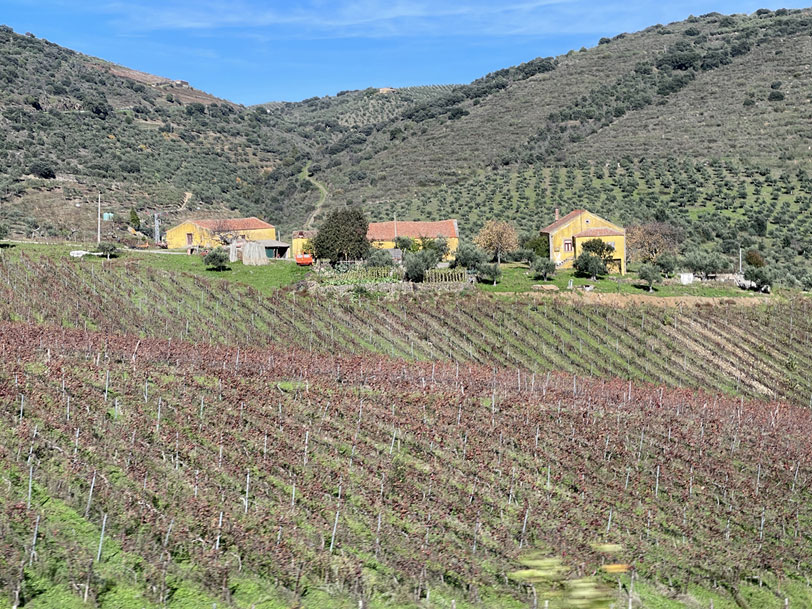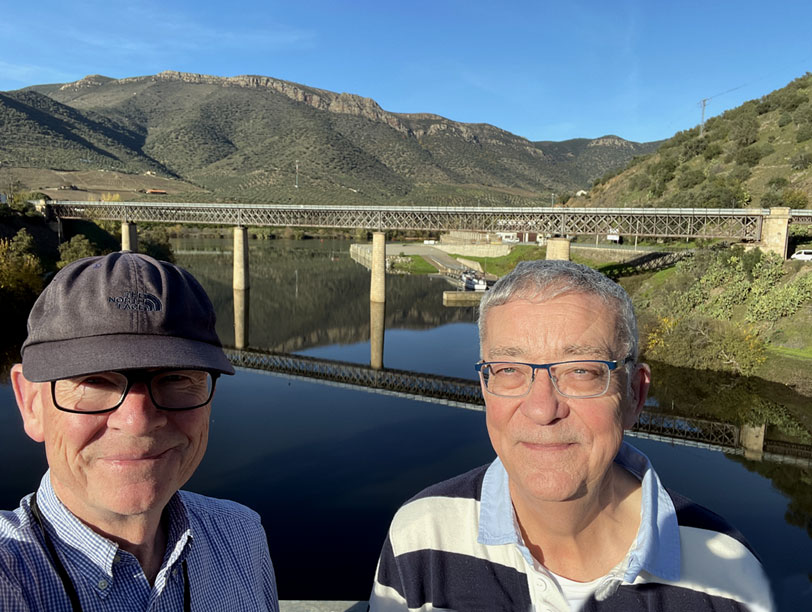|
Morning trip to Freixo de Espada
à Cinta then an afternoon walk into Spain
|
|
|
| |
Saturday 18th November 2023
|
|
|
We awoke to a slightly
misty morning in Barca d'Alva. We could see a lone fisherman
in his little boat just beyond the bridge, but there was
no sign of the Spanish port of Vega de Terron beyond, which
we were able to see quite clearly late yesterday afternoon. |
|
|
| |
Our excursion this morning
would take us on a 23km coach drive wholly within Portugal,
to Freixo de Espada à Cinta, starting off by crossing
the above bridge (bottom left on the map below). The majority
of others on the ship chose the full day excursion to the
Spanish city of Salamanca. We did consider it, but decided
that it was a rather long drive (two hours each way) so
a morning trip, with lunch back on the ship and free time
in the afternoon sounded more appealing. |
|
|
| |
First things first,
however. Today was our anniversary and perhaps we have been
together too long, because we bought each other the same
cards! |
|
|
| |
Leaving the ship after
breakfast for our excursion, we realised that there might
not be a lot to see this afternoon for our afternoon at
leisure in Barca d'Alva. |
|
|
| |
Crossing
the bridge on the coach as we set off. Our beautiful ship in the
foreground. |
|
| |
The road was twisty...very
twisty, as we followed the river separating Portugal and
Spain, which was on the other side. Geoff became quieter
and quieter. He was starting to feel queasy. Fortunately,
for the last part of the drive, the road straightened and
we were soon at our destination. |
|
| |
Tungsten
extraction, we were informed. |
|
| |
|
| |
|
| |
|
| |
|
|
| |
|
|
| |
|
| |
"Located on
Rua de São Francisco, the Casa Junqueiro Regional
Museum occupies the ground floor of what was the house of
José António Junqueiro, father of the poet
Guerra Junqueiro and popularly known as “Junqueiro
Velho”. Ethnographic in nature and regional in nature,
the rooms (6 in total) reflect a social and economic experience
typical of a wealthy house from the second half of the 19th
century (this is the case of the Dressing Room) and some
years of the 20th century, where a faithful reproduction
of the attic, an old traditional and local trade, is featured."
|
|
|
| |
|
| |
|
| |
|
| |
Leaving
the museum, we walked a short distance towards a looming tower. |
|
|
| |
|
| |
|
| |
|
| |
|
|
| |
| |
Click on the image
below to see the text clearly. |
 |
|
|
|
| |
|
|
| |
Bruce
couldn't resist the urge to climb to the top. |
|
|
| |
|
| |
|
| |
|
| |
|
| |
|
| |
|
| |
Geoff
was quite content to view it from different angles at ground level. |
|
| |
|
| |
|
| |
|
| |
We visited
the silk museum. |
|
|
| |
|
| |
|
| |
|
| |
|
| |
There
are usually quite a few people working here, but being a Saturday,
it was a bit quiet. |
|
| |
There
was, however, one lady who gave us a bit of a demonstration. |
|
| |
We got back on the coach
for a short drive out of the town to Quinta
do Salgueiro for refreshments. |
|
|
| |
|
| |
|
| |
|
| |
|
| |
|
| |
|
| |
|
| |
The owner was a lovely
lady called Margarida (a.k.a. "The Boss Lady",
according to her website) who spoke really good English.
She welcomed us warmly and led us into the dining room,
where we were treated to a selection of her home-grown produce,
including shared plates of almonds and olives followed by
Madeira cake served with mint or lemon tea. We had to hold
back slightly, because we were due back at the ship for
lunch! |
|
|
| |
After the farm visit,
we got back on the coach for our return trip to the ship.
To take Geoff's mind off the twists and turns we concentrated
on admiring the beautiful scenery. |
|
|
| |
|
| |
|
| |
|
| |
|
| |
|
| |
|
| |
|
| |
|
| |
|
| |
|
| |
|
| |
|
| |
|
| |
|
| |
|
| |
Lunch back on board
was served in the smaller Portobellos restaurant because
there weren't many of us to feed. Afterwards, we decided
to take advantage of the beautiful day and see if we could
walk across the border into Spain. We took our passports
with us, just in case, but we didn't need them. |
|
| |
Starting
off from the docking area in Barca d'Alva... |
|
| |
...we walked through
the village and then followed the bank of the river. Looking
at the route on this map, it seemed that we might be able
to walk across the disused railway bridge... |
|
|
| |
...but
when we got to the bridge, it was way up there and we were down
here, with no way of getting to it. |
|
| |
We decided
to carry on walking rather than retrace our steps. |
|
| |
A bit further along,
we walked under the road bridge, which was also inaccessible
from where we were. |
|
|
| |
We then had no choice
but to turn right, away from the river and the bridge, for
a long detour as we gradually ascended to a point where
the track met the road, from where we could turn back again
and cross the road bridge into Spain. |
|
| |
The railway
bridge, as seen from the road bridge. |
|
| |
|
| |
Half
way across the road bridge, we crossed the border... |
|
| |
|
| |
...and
then we were in Spain. We had walked almost 3km to get to this point. |
|
| |
|
| |
|
| |
From
the Spanish side, it was quite easy to climb up to the railway line. |
|
| |
|
| |
We noticed that some
people were walking across the bridge so we decided to do
the same. |
|
|
| |
|
| |
|
|
| |
|
| |
|
| |
|
| |
|
| |
We crossed
back into Portugal. |
|
| |
Looking back, it became
clear that crossing the bridge by foot was prohibited from
the Portuguese side. We saw no such signs coming the other
way. |
|
|
| |
We followed
the line all the way back to Barca d'Alva. |
|
| |
|
| |
|
| |
|
| |
|
| |
The sight of the disused
station
at Barca d'Alva was sad to see. The link provided gives
some history about it and the 21st century attempts to reopen
the line, so far without success. |
|
|
| |
|
| |
|
| |
Back on the ship and
shortly after the arrival back of our fellow passengers
after their day trip to Salamanca, we departed from Barca
d'Alva and began sailing downstream
for the first time. It was only a two hour trip to the town
of Pocinho, were we arrived after dark and stayed overnight. |
|
|
| |

|
|













































































































